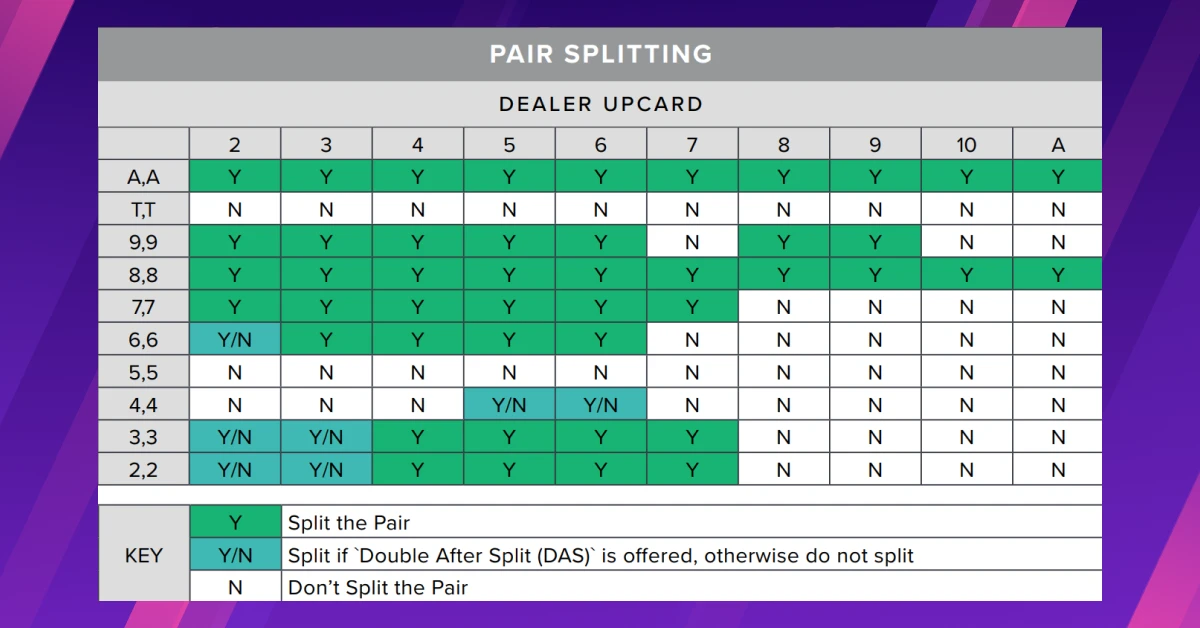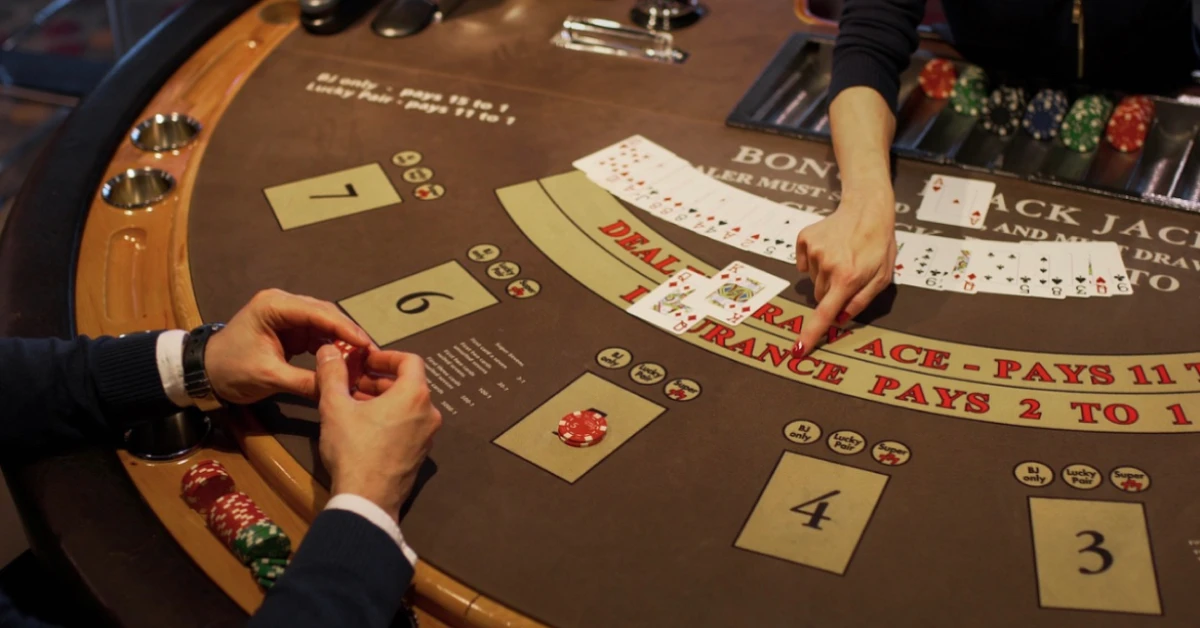The term is referred to as “blackjack deviations,” and if you’ve ever wondered what blackjack deviations are, why they matter, and how you can use them to your advantage, this guide is for you. Note: before we begin, it’s best if you have already mastered the Basic Strategy at every single hand – this way, a study of blackjack deviations will turn out to be more invaluable to your game.
So what will we talk about? It’s better if everything is logically laid out, so in this comprehensive guide, we’ll uncover:
We’re sure you’re itching to begin, so let’s dive into the world of blackjack deviations - and how they can give you the edge you've been looking for.
What are blackjack deviations?
First and foremost, let’s delve into what exactly blackjack deviations are – and, more importantly, find out how important they are. At its core, a deviation in blackjack is a deliberate play that goes against basic strategy. Basic strategy is a mathematically optimal way developed by experts to play your hand based on your cards and the dealer’s upcard, and it is not an opinion. However, basic strategy assumes a “neutral deck” - in other words, it doesn't account for the changing composition of the deck.
A blackjack deviation happens when a card counter adjusts their play based on the current count, particularly the true count. These changes are called index plays or strategy deviations. They help the player maximize winnings (or minimize losses) when the deck is rich in certain cards - especially when it comes to tens and aces.
For example:
Basic strategy might say to always stand on a hard 16 against a dealer’s 10. But if the count is very high (say, true count of +4), a deviation would suggest hitting instead. This is because the high count suggests more tens are left in the deck - making it more likely that the dealer has a strong hand, and your 16 is toast unless you improve.

Here’s a tip from the experts:
To master Perfect Basic Strategy in blackjack, create a set of flashcards. On one side, write a player hand and the dealer’s upcard; on the other, the correct action – hit, stand, double down, or split. Review these cards several times a day. After a week or two of consistent drilling, the right moves will become automatic, especially for common situations. This frees your focus for the trickier edge cases that separate good players from great ones.

Why blackjack deviations matter more than you think
If you have already been using basic strategy and card counting, you might wonder: Do I really need to learn deviations, too? The answer, in a nutshell, is yes – especially if you want to maximize your edge. Once you learn to count your cards and take advantage of card counting deviations, you will have no trouble identifying any deck, specifically those with a minus or plus True Count, or a non-neutral deck. When you can do that, card counting will become part and parcel of your tool arsenal so you can swing the advantage to your side instead of the house’s side. In other words, blackjack deviations matter because they are able to reduce the advantage of the house to the barest minimum. Below are the other reasons why blackjack deviations make a difference:
Deviations can serve to increase Expected Value
Expected Value, or EV, is the average amount you can expect to win (or lose) based on how you play a blackjack game. If you follow Perfect Basic Strategy, your EV is based on that standard way of playing.
However, using deviations means making small changes to Basic Strategy depending on which cards are left in the shoe. For example, if there are more 10s or low cards remaining, you might change your play to take advantage of that. By using these deviations, you make smarter decisions that can increase your chances of winning more money in the long run.
Deviations can decrease the variance and risk in gameplay
Adjusting your play with blackjack deviations helps lower your risk and reduce big swings in your bankroll. Since you’re always making the most accurate move based on the actual cards in play, your results will be more stable, and you’ll be less likely to hit big losing streaks. This protects your bankroll and gives you a much smoother playing experience.
Deviations equal profit optimization
Deviations are the bridge between basic strategy and advanced play. In essence, blackjack deviations allow you to:
- Optimize tough hands in high or low count situations
- Save money by avoiding poor bets
- Increase bets when the odds swing in your favor
Even just a few key deviations can likely increase your edge by 0.5% or more - which is huge in the long term.
Deviations lead to House Edge shrinkage
When you use basic strategy alone, this reduces the house edge to around 0.5%. But with counting and blackjack deviations, you may be able to flip that edge into a positive 1 - 2%, depending on penetration, rules, and spread. This may not sound like much - but over thousands of hands, it adds up to serious profits.
Understanding the count: the foundation of deviation
Keep in mind that before you are able to use deviations, you must understand exactly how the count works. Most card counters use the Hi-Lo system, where:
- 2 - 6 = +1
- 7 - 9 = 0
- 10 - A = -1
The running count is the total of these values; it is the sum of the high or the minus 1 and low or the plus 1 that were removed from the shoe. The true count is the running count divided by the number of remaining decks; it is the number of cards which have actually been removed from the shoe, and this is divided by the number of decks that remain in the shoe. Deviations are triggered when the true count hits specific thresholds.
Each deviation has an index number - the true count at which you change your play.
If you’re learning card counting, practice converting the Running Count into the True Count quickly and accurately – you’ll need to do it before nearly every hand. A great way to sharpen this skill is by observing live games.
Visit a casino (just to watch), and after each hand, estimate how many decks remain based on the discard tray. Then mentally adjust the Running Count to the True Count. Repeat this after every hand – it’s how serious counters build speed and precision.
The more hands you track, the sharper you’ll become.
How the True Count affects deviations from Basic Strategy
Consider this: as the cards are dealt, the mix of high and low cards in the shoe changes.
For example, if we're halfway through the shoe and six more low cards have been played than high cards, the Running Count is +6 – this means the remaining cards are richer in high cards (like 10s, face cards, and Aces). This gives you an edge, so you adjust your play - betting more, and making more aggressive moves like doubling down or hitting when it's likely to pay off.
On the other hand, if there are more low cards left in the shoe, you’re at a disadvantage. In that case, you bet less and play more conservatively, avoiding risky plays like doubling or splitting.

The most important deviations to learn
After you’ve perfected your card counting prowess (remember, practice is your best friend – you can also make use of a blackjack deviations chart to help) here are the top blackjack deviations every serious card counter should know. These plays are based on standard Hi-Lo indices and a 6-deck game with common rules (dealer stands on soft 17, double after split allowed).
- Insurance: Take at TC +3
This is perhaps the most well-known and popular deviation. You should never take insurance unless the true count is +3 or higher. At this point, there are enough tens left to make insurance mathematically profitable.
- 16 vs. 10: Stand at TC 0 or higher
Basic strategy says hit. But remember: if the count is neutral or positive, you stand. There’s a higher chance the dealer will bust if the deck is rich in tens.
- 15 vs. 10: Stand at TC +4
This is another classic high-count deviation. At TC +4, there’s enough reason to believe the dealer will bust more often, so you stand on your vulnerable 15.
- 10 vs. 10: Double at TC +4
Normally, you just hit here. But at TC +4, the deck is so loaded with tens that doubling becomes the far better option.
- 12 vs. 3: Stand at TC +2
Basic strategy says hit. But if the true count is +2 or more, standing is stronger.
- 12 vs. 2: Stand at TC +3
Similarly, you stand instead of hitting when the count is rich enough in high cards.
- 13 vs. 2 and 13 vs. 3: Stand at TC -1 or lower
In a very low count, you hit instead of stand. This is a rare reverse deviation, used when the deck is rich in low cards.
- Double 11 vs. Ace at TC +1
Basic strategy says not to double against a dealer Ace. But when the count hits +1 or more, doubling gives you an edge.

How to recognize when to deviate
So after all is said and done, how do you recognize when you should deviate? Again, although no strategy is fool-proof, having a good understanding of the signs to look for should do the trick. Following are a few signs that will tell you when you can deviate:
- Know your index numbers cold
Make it a point to memorize the top 10–20 blackjack deviations. Mind you, you don’t need to learn 100+ right away — you can start with the most profitable ones, especially those that come up often (like 16 vs. 10 or insurance decisions).
- Use flashcards and drills
You should also practice deviations with apps, card-counting drills — and try to memorize a blackjack deviations chart. It is of the utmost importance to remember that repetition is key until your decision-making becomes automatic and second-nature.
- Pay attention to True Count fluctuations
No matter what you are feeling at the moment, don’t rely on instincts. Always use the True Count as your guide. Deviations are only profitable when applied at the right count thresholds.
- Adjust by rule variations
Deviations can vary based on the number of decks or rules, so make sure you’re using the right index set for the game you’re playing.
Top strategies you can use to master deviations right now
Fortunately, there are also a host of different strategies you can use at the moment in order to master deviations. These are as follows:
1. Prioritize high-frequency decisions
Some deviations only come up rarely – so focus first on decisions that occur often and offer decent EV gains.
For instance, the following are recommended:
- Insurance (TC +3)
- 16 vs. 10 (TC 0)
- 15 vs. 10 (TC +4)
- 12 vs. 3 (TC +2)
2. Keep a deviation chart handy
Before you hit the casino, here’s another recommendation from the experts: review your blackjack deviations chart. If possible, you can also use practice tools like Casino Verité, Blackjack Apprenticeship trainer, and flashcard apps.
3. Track your accuracy
You should also make it a point to log hands you’ve played or simulate sessions online. Track how often you recognize - and apply - deviations correctly.
4. Group by count range
It would be wise to group deviations by count range for easier memorization. For example:
- TC +1 to +3: Insurance, 12 vs. 3, double 11 vs. Ace
- TC +4 or higher: 10 vs. 10 double, 15 vs. 10 stand
The cost of ignoring deviations
You may be wondering if there are any real costs to not making use of deviations – in short, is it really worth using them? In truth, many counters stop short of learning deviations, thinking the gains are minor. But we can tell you right now that over thousands of hands, we’ve proven that even tiny advantages make a big difference. Think about it – see below:
Without deviations:
- You may leave up to 50% of your potential profit on the table
- Misplays in high-count situations can cost you
- You cap your skill level
All in all, deviations turn a break-even card counter into a winning one.
Common mistakes you can easily avoid when you use blackjack deviations
There are two common mistakes you can avoid when using blackjack deviations. One big mistake is not memorizing the table. Since you obviously can’t use it at the table, you need to know it by heart. If you don’t remember it well, you might make the wrong plays - and this can cost you money.
Another common error is not adjusting your bets based on the count. Also, if you’re not playing perfect Basic Strategy or counting cards accurately, the deviation chart won’t do much good. To make the most of it, you need to count cards correctly and play each hand the right way.
Pitfalls to stay away from
- Overusing deviations
It’s best not to deviate unless the count truly justifies it. Making incorrect deviations is way worse than just following basic strategy.
- Not adjusting for game conditions
Some deviations change based on the number of decks or specific house rules. That said, you should always check the index set for the game you’re playing.
- Failing to practice under pressure
If you didn’t know it by now, deviations require fast mental math in a live casino setting. If you can't apply them in real time, they won’t help! You can further simulate the pressure through online trainers.
- Getting greedy or distracted
It’s crucial to stay focused. Don’t let big bets distract you from making correct plays. Stick to your training and discipline in card counting deviations and all else will follow.

Deviations as the next level of play
If you’ve already learned basic strategy and card counting, deviations are your next big leap. While they may seem like small changes, their entire cumulative effect is powerful. When you can master even the top 10 - 20 deviations, this can turn you into a razor-sharp player capable of shifting the house edge in your favor.
Quick reference
| Play |
Deviation |
True Count |
| Insurance vs. Ace |
Take |
+3 |
| 16 vs. 10 |
Stand |
0 |
| 15 vs. 10 |
Stand |
+4 |
| 12 vs. 3 |
Stand |
+2 |
| 12 vs. 2 |
Stand |
+3 |
| 13 vs. 2/3 |
Hit |
-1 |
| 10 vs. 10 |
Double |
+4 |
| 11 vs. Ace |
Double |
+1 |
Are you ready to take the edge?
If you’re serious about mastering blackjack, learning deviations is a must. With the right knowledge and practice, these small strategy shifts will give you an undeniable edge - one that actually separates skilled players from the rest of the pack. So start small, stay consistent, and the edge will be yours.
Take the leap from basic to pro-level blackjack
By now, it should be clear that blackjack deviations aren’t just optional add-ons for card counters - they’re actually an essential next step if you would like to turn a solid strategy into a winning one. While basic strategy and card counting provide the foundation, blackjack deviations are where your skills truly come to life. They allow you to fine-tune your plays in real time, maximize your profit, minimize your losses, and smooth out variance across countless hands.
To be sure, memorizing deviations and applying them under pressure takes a lot of discipline - but the reward is undeniable: a razor-thin edge that, over time, becomes the difference between merely breaking even and becoming a consistent winner. Remember, even a 0.5% increase in edge can mean thousands of dollars saved or earned over a lifetime of play!
So if you’re committed to beating the house, don’t stop at just counting cards. Learn the key blackjack deviations, drill them until they’re second nature, and keep sharpening your game. With patience and practice, you’ll elevate your blackjack strategy to a level most players never reach - and the edge will finally be under your command.












































